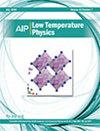Direct UV absorption spectra of CO2+ in solid neon
IF 0.8
4区 物理与天体物理
Q4 PHYSICS, APPLIED
引用次数: 0
Abstract
The IR and UV absorption spectra of CO2+ isolated in solid neon were studied by using our newly built mass-selective matrix isolation system. The IR absorption spectrum revealed the formation of CO2 in both cationic and anionic forms in solid Ne, since neutral CO2 was also used to serve as an electron scavenger in this study. Subsequently, we recorded the UV absorption spectrum of the same matrix sample in the spectral region 270−400 nm, encompassing the electronic transitions of CO2+ from the ground state to the first two electronic excited states. Notably, the observation of the electronic transition A2Πu←X2Πg was dominated by the vibrational progression of the symmetric CO stretching mode, while a single sharp band was observed in the electronic transition B2Σu+←X2Πg. The presented spectra might be useful for future studies on terrestrial and astrochemical conjunctions.固态氖中 CO2+ 的直接紫外吸收光谱
我们利用新建立的质量选择性基质分离系统研究了在固体氖中分离出的 CO2+ 的红外和紫外吸收光谱。红外吸收光谱显示在固体氖中形成了阳离子和阴离子形式的 CO2,因为在本研究中中性 CO2 也被用作电子清除剂。随后,我们记录了同一基质样品在 270-400 nm 光谱区的紫外吸收光谱,其中包括 CO2+ 从基态到前两个电子激发态的电子跃迁。值得注意的是,对电子跃迁 A2Πu←X2Πg 的观察主要是对称 CO 伸展模式的振动进展,而在电子跃迁 B2Σu+←X2Πg 中则观察到一个单尖锐带。所提供的光谱可能有助于今后对陆地和天体化学结合的研究。
本文章由计算机程序翻译,如有差异,请以英文原文为准。
求助全文
约1分钟内获得全文
求助全文
来源期刊

Low Temperature Physics
物理-物理:应用
CiteScore
1.20
自引率
25.00%
发文量
138
审稿时长
3 months
期刊介绍:
Guided by an international editorial board, Low Temperature Physics (LTP) communicates the results of important experimental and theoretical studies conducted at low temperatures. LTP offers key work in such areas as superconductivity, magnetism, lattice dynamics, quantum liquids and crystals, cryocrystals, low-dimensional and disordered systems, electronic properties of normal metals and alloys, and critical phenomena. The journal publishes original articles on new experimental and theoretical results as well as review articles, brief communications, memoirs, and biographies.
Low Temperature Physics, a translation of the copyrighted Journal FIZIKA NIZKIKH TEMPERATUR, is a monthly journal containing English reports of current research in the field of the low temperature physics. The translation began with the 1975 issues. One volume is published annually beginning with the January issues.
 求助内容:
求助内容: 应助结果提醒方式:
应助结果提醒方式:


